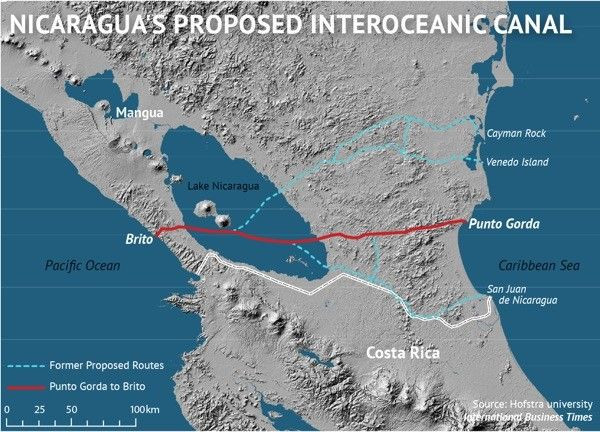Nicaraguan Canal Closer To Reality After Officials, Hong Kong Developers Approve Proposed Route

The Nicaraguan government and the Hong Kong-based developer behind a $40 billion shipping canal that would slice the Central American country in half approved a proposed route on Monday after weeks of hinting that they might disclose the details.
The canal would run 172 miles from Punta Gorda on the Caribbean coast through Lake Nicaragua – one of the world’s largest lakes – and out the mouth of the Brito river on the Pacific side, according to the committee of government officials, business people and academics who agreed on the plan.

The group had floated five other proposed routes but settled on this one because it would avoid areas of great biodiversity, indigenous territories and protected lands, Reuters reported. The project has drawn criticism internationally from environmental groups and government transparency advocates who claim the project could destroy fragile ecosystems while lining the pockets of politicians and Chinese investors.
The Nicaraguan canal would measure 755 feet to 1,706 feet wide (at its narrowest and widest) and 90 feet deep, said engineers for the Hong Kong Nicaragua Development (HKND) Group, led by the enigmatic Chinese billionaire Wang Jing. The shipping channel will be three times the length of the Panama Canal, which cuts across the narrowest part of the Central American isthmus.
Nicaraguan officials have heralded the project as a boon for the impoverished country, which is the second poorest nation in the Western Hemisphere behind Haiti. Paul Orquist, a closer adviser to President Daniel Ortega, told the BBC that the projects surrounding the canal, including the creation of two free-trade zones, two ports linked by rail and an international airport, would create “a formative change in job creation.” Revenues from the project could help to lift more than 400,000 people out of general poverty by 2018, according to the government.
The shipping industry has also shown interest in the canal, which would accommodate massive tankers that are too large for the Panama Canal and save ships about 500 miles on the journey from New York to Los Angeles, Keith Svendsen, who heads daily operations at Maersk Line (OTCMKTS: AMKBY), the world’s biggest container shipping company, has said.
“Building a Nicaragua canal seems to make good sense,” he told the Danish publication ShippingWatch in June. Maersk Line, however, quickly distanced itself from Svendsen’s comment, stating that it has “insufficient information at the moment to be able to evaluate the Nicaragua Canal.” The company added that, “In general, and as potential users of such infrastructure, we maintain a positive attitude toward the possibility of having several options for our business.”
Environmentalists, on the other hand, have blasted the project. They say it would destroy tens of thousands of acres of rainforests and wetlands and contaminate Lake Nicaragua, a major source of fresh water and home to many aquatic species. It would also disrupt life in many of the autonomous indigenous communities along the canal’s route.
“This canal could create an environmental disaster in Nicaragua and beyond,” Jorge Huete-Perez, the head of the Nicaraguan Academy of Sciences, and evolutionary biologist Axel Meyer wrote in a February commentary in Nature magazine. They called for an independent environmental impact assessment that could help protect "some of the most fragile, pristine and scientifically important marine, terrestrial and [lake-related] ecosystems in Central America.”
Opposition lawmakers said they are skeptical that the project can deliver all that the government has promised. Congressman Eliseo Núñez of the Independent Liberal Party called the announcement of the canal route "a propaganda game, a media show to continue generating false hopes of future prosperity among Nicaraguans,” the BBC reported.
The Nicaraguan canal committee said that it would carry out environmental and social impact studies along the proposed route this year, and that changes would still be possible. Construction on the canal is slated to start in December and last through 2019, with operations beginning in 2020.
© Copyright IBTimes 2024. All rights reserved.




















